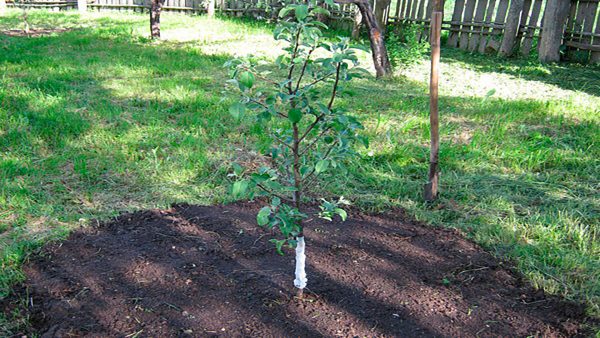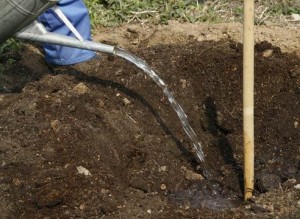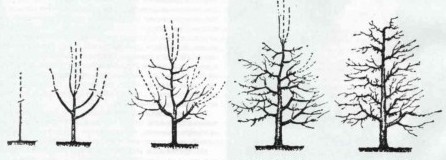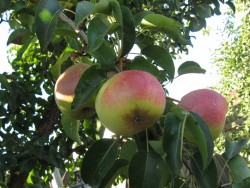Content:
- Planting a pear.
- Pear pruning.
- Caring for pears.
Pear is one of the most popular fruit crops grown in garden plots. Currently, many new varieties have been developed that are resistant to scab disease, produce high yields and are winter-hardy. All this greatly simplifies caring for pears.
Temperature
In most of its biological characteristics, the pear is close to the apple tree and has similar agricultural technology, however, this tree is more heat-loving and can die in a cold winter. The critical winter temperature for it is -26 C. Pear flowers are damaged at a temperature of -2 °C. Fruit ovaries can withstand temperatures down to -4 'C.
Planting a pear
When to plant. It is preferable to plant all trees in the spring, but in the southern regions, autumn planting of pears can also be practiced. If you plant in the fall, try to do this at least a month before the onset of frost. Then the seedling will have time to take root in a new place. The best time for spring planting is the end of April.
To achieve a good harvest, plant the pear tree on a hill. Low-lying areas are completely unsuitable for it.
Where is the best place to plant? When choosing a planting site, remember that this plant has a deep root system, which requires nutrient-rich and fairly loose soil. Loamy and clayey soils are considered the most optimal for pears. It is not recommended to plant this tree on heavy clay and light sandy soils.
Pear does not like carbonate, acidic soils and saline soils. Close groundwater has a detrimental effect on it. When the roots grow into this waterlogged layer, they rot and the tree dies. The depth of groundwater must be at least 3 m.
If you plan to plant a pear in the spring, dig a planting hole in the fall, and if in the fall, then 3 weeks before planting.
Try to preserve as many roots as possible from the seedling so that the tree survives planting well. You can dip the roots in soil mash with the addition of a heteroauxin solution.The main requirement when planting seedlings is that there are no air bubbles left in the root zone.
Planting pits. If the pear is grafted onto a vigorous rootstock, dig a planting hole with a diameter of 100-120 cm and a depth of 60 cm. If the rootstock is dwarf, the hole should be 60-70 cm in diameter and 50-60 cm deep.
If the soil on your site is clay or loamy, add mineral and organic fertilizers to the planting holes. Add 1 tbsp to sandy soil. a spoonful of complex mineral fertilizer (AVA, for example) and 2-3 buckets of rotted manure or compost.
Drive a peg into the middle of the hole and add fertilized soil to 1/2 the volume of the hole. Place the seedling in the hole on the north side of the peg, fill the hole and make a hole around the plant with a diameter of 60-70 cm.
After planting, do not trample the soil around the seedling. Dense, moist soil does not allow oxygen to reach the roots. It is better to gradually add fertile soil and moderately water the tree trunk circle so that the wet soil fills the voids in the hole and sticks to the roots.
Do not bury the seedling when planting. This inhibits the growth of the tree and the time it begins to bear fruit, and stimulates the appearance of root shoots. If the planting hole is well filled, fertilizing is not required for two or even three (if AVA was added) years.
After planting (or with the onset of spring if planting in autumn), shorten the central conductor and side branches by one quarter or a third if the spring is dry. This way you will restore the balance between the above-ground part and the root system of the seedling, which was disturbed during digging.
How to trim pears
Formative pruning for tall trees
For tall trees reaching 5 m, it is best to form a sparsely tiered crown, since it most closely matches the natural growth of the tree. Perform pruning in the first 5-6 years after planting, and then only perform periodic trimming.
For skeletal ones, choose strongly growing branches. Form 2-3 tiers in the crown, 3-4 branches per tier. Branches of different tiers should be at a distance of 60-80 cm from each other.
Formative pruning for trees up to 4 m high.
For trees reaching a height of 3.5-4 m, as well as for those growing in dense conditions, it is preferable to form a palmette-type crown. In this case, place both the main and overgrowing branches in the same vertical plane. Lay no more than 8-12 skeletal branches. The angle of inclination of the lower branches should be about 50º; those located above should be 60-80º.
During the formation of the crown, annually cut the central conductor 40-70 cm above the base of the upper skeletal branch. Don’t forget to cut out competing branches, vertical shoots and some of the excess growth in the area of skeletal branches into the ring.
Rejuvenating pear pruning
Old trees often have reduced productivity, so it is recommended to rejuvenate them. To do this, cut the skeletal branches at a distance of 1.5 m, first removing the dried and diseased ones, as well as those that grow inward or upward.
If you bend the branches horizontally, they will bear fruit. This is very important in case of severe damage to the main branches. Annual shortening pruning can smooth out the frequency of fruiting.
Pear care
Caring for pears consists of fertilizing, watering and formative pruning.
Tree trunk circle
The tree trunk circle also needs to be looked after, because the yield of the pear will largely depend on the condition of the tree trunk circle. Keep the soil loose and be sure to remove root growth.
Watering pears
The pear does not need too frequent or abundant watering. Watering is required immediately after flowering, when the ovaries reach the size of a walnut, after harvesting and at the beginning of leaf fall. Water not under the trunk, but around the perimeter of the crown. In hot, dry summers, watering once every three weeks is sufficient.
After watering, loosen the soil and mulch it with dry soil, grass or straw to avoid loss of moisture from the subsoil.
Feeding pears
In the first year of life, the plant needs enough fertilizers applied during planting, then mineral fertilizers should be applied annually. Apply organic fertilizers once every 3 years. In this case, per 1 m2 there should be 5-10 kg of compost or manure, 30-50 g of superphosphate, 20-30 g of potassium chloride and 10-15 g of urea. Use nitrogen fertilizers in the spring and after flowering of fruit-bearing trees.
In the fall, apply a full dose of organic, phosphorus-potassium and 1/3 of the norm of nitrogen fertilizers. From April to May, fertilize with nitrogen fertilizers, and in June-July - with phosphorus and potassium fertilizers.
When applying fertilizing, take into account the varietal characteristics of the pear, the composition and level of soil moisture.
It is recommended to apply fertilizers in a circular groove 25-30 cm deep, carefully dug along the periphery of the crown. For your attention and careful care, the pear will definitely thank you with tasty, juicy fruits.
Pears, like other fruit trees, require timely spraying against pests and diseases.In late autumn or early spring (before the start of sap flow) - spraying and washing the trees with a urea solution (500-700 g per 10 liters of water). A good preventive measure is spraying once a month from May to August with a solution of Epin-extra + zircon.
You can read how to deal with scab on a pear Here.
Wintering pears. A serious test for pears is winter, especially one with little snow, with frosts, thaws, daily temperature changes, and strong winds.
Helps trees more easily endure winter weather troubles with immunostimulants: Epin-extra, Novosil (Silk), Ecoberin.
Late autumn whitewashing (2-2.5 kg of lime + 1 kg of clay + 300 g of copper sulfate per 10 liters of water) will protect trees from frost damage and sunburn, and for young trees - wrapping trunks with synthetic light materials: sugar burlap without film , spunbond, nylon tights.
Watch the video “Pruning a pear”





 CUCUMBERS NEVER GET SICK, I'VE BEEN USING ONLY THIS FOR 40 YEARS! I SHARE A SECRET WITH YOU, CUCUMBERS ARE LIKE THE PICTURE!
CUCUMBERS NEVER GET SICK, I'VE BEEN USING ONLY THIS FOR 40 YEARS! I SHARE A SECRET WITH YOU, CUCUMBERS ARE LIKE THE PICTURE! You can dig a bucket of potatoes from each bush. Do you think these are fairy tales? Watch the video
You can dig a bucket of potatoes from each bush. Do you think these are fairy tales? Watch the video
 How our fellow gardeners work in Korea.There is a lot to learn and just fun to watch.
How our fellow gardeners work in Korea.There is a lot to learn and just fun to watch. Eye trainer. The author claims that with daily viewing, vision is restored. They don't charge money for views.
Eye trainer. The author claims that with daily viewing, vision is restored. They don't charge money for views. A 3-ingredient cake recipe in 30 minutes is better than Napoleon. Simple and very tasty.
A 3-ingredient cake recipe in 30 minutes is better than Napoleon. Simple and very tasty. Therapeutic exercises for cervical osteochondrosis. A complete set of exercises.
Therapeutic exercises for cervical osteochondrosis. A complete set of exercises. Which indoor plants match your zodiac sign?
Which indoor plants match your zodiac sign? What about them? Excursion to German dachas.
What about them? Excursion to German dachas.